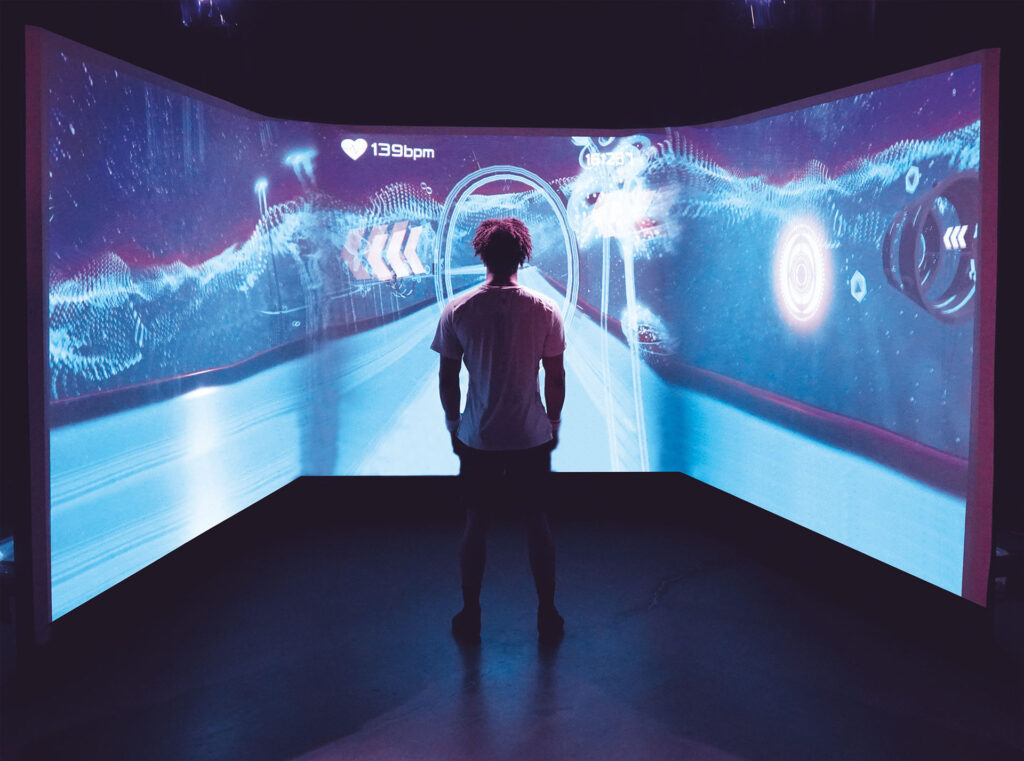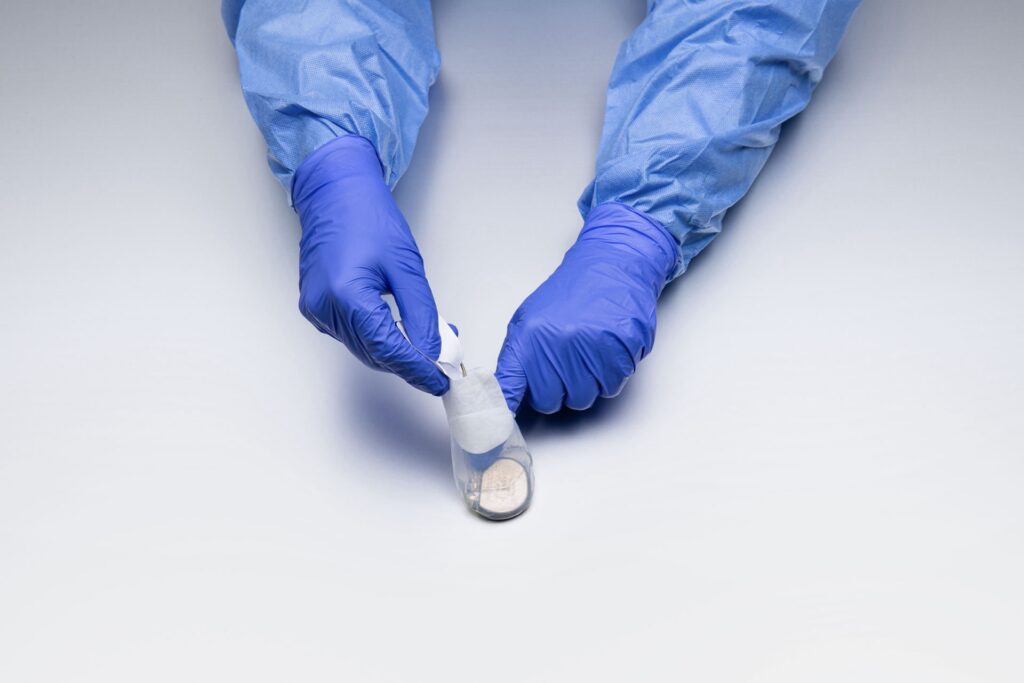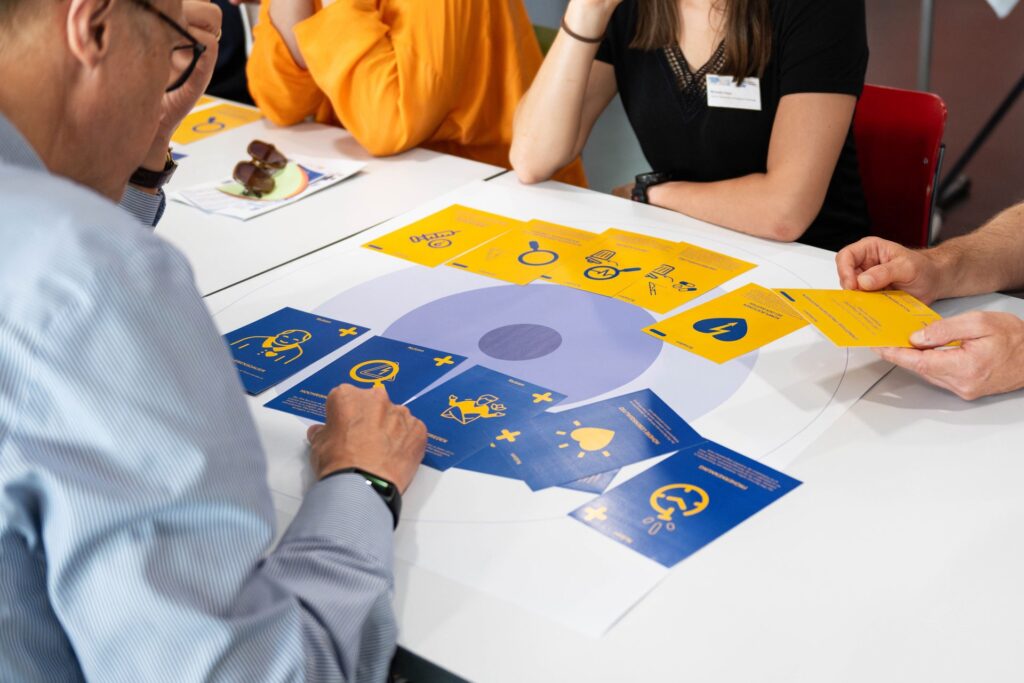
How design is revolutionizing (digital) healthcare: Three innovative projects.
About the authors
Anna Lisa Martin-Niedecken heads the Institute for Design Research at the Department of Design. Annina Gähwiler and Laurin Schaffner are research assistants at the same institute.
Our health and its impairment or restoration are ongoing issues. Innovative technologies provide possible solutions, new approaches open up unexpected perspectives and changing needs influence human behaviour. Amid these developments, one matter is plainly evident: complex challenges require interdisciplinary collaboration.
ZHdK’s Design Department has been pursuing research and development projects with partners across the healthcare system for over ten years. The Health Design Cluster at the Institute for Design Research serves these projects as a joint platform to further develop this field. Design focuses on key areas of healthcare such as Care Futures, Ageing, Health Technologies, Games for Health, Sports and Physical Activity or Digital Health. It also drives innovation at the interfaces between medical specializations and beyond.
Interdisciplinary Living Lab for Digital Health Design
Digitalization is also playing a key role in the healthcare sector, whether in the form of virtual medical visits, AI-based self-diagnosis apps or technology-based rehabilitation and fitness training in extended realities. Tracking and permanently available health data enable us to assume more personal responsibility and actively shape our health. It is crucial that therapists, physicians and professionals design customized treatment strategies based on increasingly comprehensive data and more complex correlations. To do so, they must be able to access intelligible and well-designed data.
The Digital Health Design Living Lab (DHD Living Lab) is funded by the Digitalization Initiative of Zurich Higher Education Institutions (DIZH). It brings together three Zurich-based universities (ZHdK, UZH and ZHAW), medical professionals, patient organizations and the public to develop new and practicable ideas for future healthcare. In doing so, the Living Lab actively involves patients, relatives and the public to understand their needs and wishes. This interdisciplinary collaboration contributes to strengthening trust in the healthcare system.
Co-creation: The example of Exergames
Exergames are movement-based games. They use digital gaming technology to combine physical activity with an entertaining experience. Sensors record the body movements required for game control. The knowledge gained can be used to optimize physical, mental and cognitive functions as well as individual training. Today, exergames are used in the fields of sport, fitness and rehabilitation.
Ideally, such games are developed by interdisciplinary teams involving experts in sports science, game design and human-computer interaction. Interdisciplinary and iterative design research plays a crucial role. First, focus groups comprising athletes or therapists, for example, determine the basic requirements for exergames. Where, how and when should they be used? Which design would be ideal? Which movement concept is suitable? And which technology should be used?
Initial concepts define movement sequences that are based on the findings of training and movement science and are initiated through bodystorming—a creative method in which physical interactions and experiences are played out to generate ideas. The generated effects should feel as playful as possible. At the same time, controller properties from gesture-based game control to haptic interaction can be explored. Other key aspects include audio-visual and narrative design. The concepts are subsequently transferred into interactive prototypes and evaluated in tests with the target group. Both qualitative and quantitative methods are often used to analyze the quality of the design elements and their interaction. Based on these tests, the R&D process concludes with a training intervention aimed at analysing the training effects and the gaming experience.
Several iteration loops not only lead to new interdisciplinary research insights but also to a final product with unique selling points and proven usefulness. These exergame projects are funded by various organizations, including Innosuisse, AAL, DIZH and the Sports Fund of the Canton of Zurich.
Digital remote testing methods: The example of 3FOLD
Pacemakers control the heart rhythm of cardiovascular patients. The Hylomate Pouch—a protective sheath made of biosynthetic material—minimizes foreign body reactions to these devices and thus improves their integration. 3FOLD is designed to enable encasing the pacemaker prior to implantation in an aseptic and time-saving procedure.

Funded by Innsouisse, the 3FOLD project focused on user-centred design and rapid prototyping to develop a foldable applicator. The device enables a safe and fast surgical procedure during which the pacemaker is wrapped in the Hylomate Pouch. The project team also developed a digital design method that enables remote usability testing of medical products.
To this end, the procedural environment was first analyzed and reproduced for remote testing. Next, cardiologists and cardiothoracic surgeons were given the physical material to set up the test environment. The field of vision and lighting were checked via video conference and the tests were moderated and recorded. Afterwards, the test persons answered some questions about the tests. The video recordings were analyzed independently by several researchers and according to clear guidelines. The data and insights gained were incorporated into product development and resulted in the final design.
The newly developed method has proven itself in practice: It enables flexible time management with the surgeons, saves time-consuming and costly travel and the installation of a test setup, and will now serve as the basis for further remote tests in developing physical medical devices.
Changing perspectives: “Mind the Patient”
How can physicians and patients improve healthcare? How can treatment decisions be made on equal terms while considering personal preferences? Based on shared decision-making (SDM), the “Mind the Patient” project addresses these questions. To optimize SDM, the DHD Living Lab has defined the requirements for a digital tool that makes personal values and preferences visible.

Instead of digitizing paper-based products, the project team adopted a new, analog approach. The SDM process is transferred into the physical dimension and can be experienced in a multisensory and multimodal way. This multi-sensory immersion in situations requiring deliberation and decision can help research participants how immersion affects them.
The experimental research design enabled test persons with a medical or medical-ethical background to change their perspective and immersively experience decision-making situations. Playful approaches in three experimental spaces invited members of the focus group to explore cards as artifacts (e.g. laying out cards on a table), colours, light and sounds. Moving through the three rooms, the small groups assumed different roles. They used the think-aloud method to document their experiences in terms of information, interaction and emotion. Next, a focus group discussed the results and derived approaches for the digital design of an SDM tool.
Outlook
The healthcare sector is facing numerous challenges. These, however, are matched by the potential of new and innovative technologies. Designers work hand in hand with R&D teams and thus play an important role in implementing new products and services. While managing such processes requires specially trained and interdisciplinary specialists, they also offer physicians, health professionals, coaches and therapists valuable insights into design practice. To this end, the DHD Living Lab actively contributes to joint teaching and continuing education programmes. To bolster its contribution to advancing healthcare, the Design Department offers a summer school (Health Design Think Tank) and has developed a new minor (Health Design) as part of ZHdK’s programme reform.
In addition, the DHD Living Lab regularly organizes healthathons where interdisciplinary teams develop solutions to real-life cases. The DHD Living Lab network is growing and welcomes new partners keen to help shape tomorrow’s healthcare. Health we go!
This article was published on July 8, 2024 on zhdk.ch.
Further links:
The DHD Living Lab is funded as part of the 1st structure call in the DIZH innovation program.